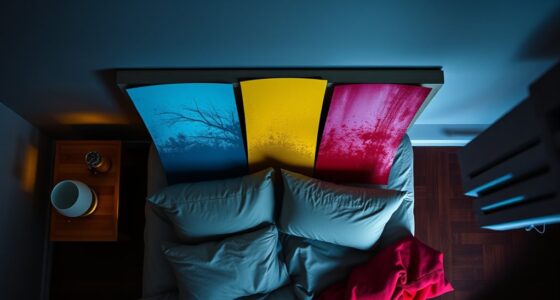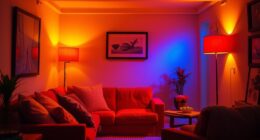To improve your mood using color therapy, start by blending calming hues like blue and green for relaxation or energizing reds and oranges for motivation. Use visualization techniques, imagining colors flowing through your body to target specific feelings, and adjust your environment with colored lighting or textiles. Combining these methods creates a personalized space that supports your emotional well-being. Exploring further will reveal even more ways to harness color for your mood and mindset.
Key Takeaways
- Use color visualization techniques by imagining calming hues like blue or green to evoke relaxation and reduce stress.
- Incorporate color blending, such as combining warm reds with soft pinks, to foster feelings of love and emotional warmth.
- Apply colored lighting or textiles in environments to create mood-specific atmospheres, like soothing blue for tranquility.
- Select colors based on their symbolism—blue for calmness, yellow for energy—to support desired emotional states.
- Combine practical tools like painted walls or colored filters with mindfulness practices to enhance mood improvement efforts.

Color therapy, also known as chromotherapy, harnesses the power of specific colors to influence your mood, energy, and overall well-being. When you understand color symbolism, you gain insight into how different hues evoke particular feelings and reactions. For example, you might associate blue with calmness or red with excitement, and these associations can be utilized intentionally to enhance your mental state. By selecting colors aligned with your desired emotional outcome, you can create a more supportive environment for relaxation, focus, or motivation.
A key aspect of effective color therapy involves color blending, which is the art of combining hues to produce nuanced effects. Instead of relying on a single color, you can incorporate multiple shades to balance or amplify specific energies. For instance, blending calming blue with invigorating yellow can foster a sense of peaceful energy, making it ideal for workspaces or meditation areas. Conversely, mixing warm reds with soft pinks might boost feelings of love and compassion. You can achieve this through various techniques, like painting walls in harmonious color combinations, using colored lighting, or incorporating colored objects and textiles into your space. This approach allows you to tailor your environment to your emotional needs and create a more dynamic, personalized experience.
Color blending also plays a role when you’re actively practicing color visualization or meditation. Imagine envisioning a gradient of colors flowing through your body, each hue representing different aspects of your emotional or physical state. This mental technique can deepen your connection with the colors and their symbolic meanings, enhancing the therapeutic effect. When you understand how colors can be combined or layered, you’re better equipped to design interventions that resonate with your unique preferences and goals. For example, you might blend soft greens and blues to promote tranquility or fiery oranges and reds to stimulate motivation. Additionally, understanding Cost and Budgeting considerations can help you select affordable materials and techniques to incorporate color therapy into your space without overspending.
Frequently Asked Questions
Can Color Therapy Replace Traditional Mental Health Treatments?
Color therapy can’t replace traditional mental health treatments, but it can complement your holistic healing approach. By understanding color symbolism, you might find it enhances your mood and supports emotional well-being. However, it’s crucial to consult mental health professionals for serious issues. Incorporate color therapy as a supportive tool alongside therapy or medication, knowing it offers added benefits without replacing evidence-based treatments.
How Long Should a Color Therapy Session Last?
A stitch in time saves nine, so keep your sessions effective. Typically, a color therapy session lasts around 20 to 30 minutes, which is considered ideal timing for mood improvement. You should focus on your comfort and response, adjusting the session length if needed. Avoid overdoing it, as longer sessions may diminish benefits. Listen to your body and consult a professional for personalized guidance.
Are There Any Risks or Side Effects?
Color therapy is generally safe, but you should always follow safety precautions to avoid potential allergies or adverse reactions. Be aware of any skin sensitivities or allergies to specific colors or lights used. If you notice irritation or discomfort, stop immediately and consult a professional. Using caution ensures a positive experience, and discussing your health history with a practitioner can help minimize risks and guarantee the therapy is safe and effective for you.
Which Colors Are Most Effective for Anxiety?
Calming shades like blue and green are most effective for anxiety because they embody soothing color associations. You’ll find that these gentle hues help relax your mind and reduce stress. Incorporate calming shades into your environment through décor, clothing, or visualizations. By embracing these serene colors, you can create a peaceful space that promotes relaxation and eases anxious feelings naturally and effectively.
Is Color Therapy Suitable for Children and Seniors?
Yes, color therapy can be suitable for children and seniors. It supports emotional development and helps improve sensory processing, which is especially beneficial for those with emotional or sensory sensitivities. You should tailor the techniques to their needs, using calming or stimulating colors to promote relaxation or alertness. Always consult a professional to guarantee the therapy aligns with their individual health conditions and emotional needs.
Conclusion
By incorporating color therapy into your routine, you can harness the power of colors to boost your mood and overall well-being. Studies show that up to 70% of people experience improved emotional states through color exposure. So, don’t underestimate the simple yet effective impact of colors around you. With consistent practice and awareness, you’ll find that a splash of color can truly transform your mental outlook and brighten your days.








